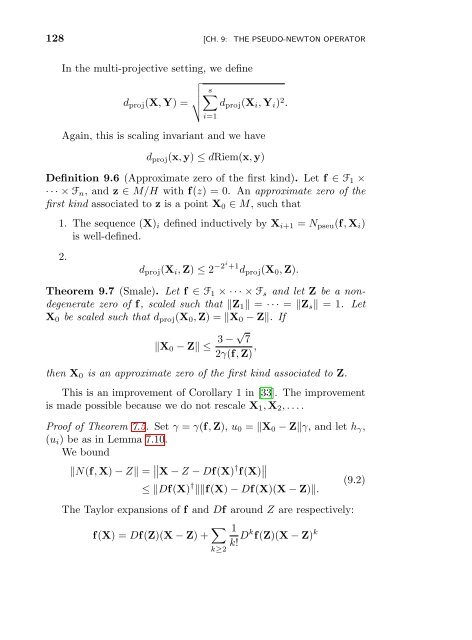Nonlinear Equations - UFRJ
Nonlinear Equations - UFRJ
Nonlinear Equations - UFRJ
You also want an ePaper? Increase the reach of your titles
YUMPU automatically turns print PDFs into web optimized ePapers that Google loves.
128 [CH. 9: THE PSEUDO-NEWTON OPERATOR<br />
In the multi-projective setting, we define<br />
∑<br />
d proj (X, Y) = √ s d proj (X i , Y i ) 2 .<br />
i=1<br />
Again, this is scaling invariant and we have<br />
d proj (x, y) ≤ dRiem(x, y)<br />
Definition 9.6 (Approximate zero of the first kind). Let f ∈ F 1 ×<br />
· · · × F n , and z ∈ M/H with f(z) = 0. An approximate zero of the<br />
first kind associated to z is a point X 0 ∈ M, such that<br />
1. The sequence (X) i defined inductively by X i+1 = N pseu (f, X i )<br />
is well-defined.<br />
2.<br />
d proj (X i , Z) ≤ 2 −2i +1 d proj (X 0 , Z).<br />
Theorem 9.7 (Smale). Let f ∈ F 1 × · · · × F s and let Z be a nondegenerate<br />
zero of f, scaled such that ‖Z 1 ‖ = · · · = ‖Z s ‖ = 1. Let<br />
X 0 be scaled such that d proj (X 0 , Z) = ‖X 0 − Z‖. If<br />
‖X 0 − Z‖ ≤ 3 − √ 7<br />
2γ(f, Z) ,<br />
then X 0 is an approximate zero of the first kind associated to Z.<br />
This is an improvement of Corollary 1 in [33]. The improvement<br />
is made possible because we do not rescale X 1 , X 2 , . . . .<br />
Proof of Theorem 7.5. Set γ = γ(f, Z), u 0 = ‖X 0 − Z‖γ, and let h γ ,<br />
(u i ) be as in Lemma 7.10.<br />
We bound<br />
‖N(f, X) − Z‖ = ∥ ∥X − Z − Df(X) † f(X) ∥ ∥<br />
≤ ‖Df(X) † ‖‖f(X) − Df(X)(X − Z)‖.<br />
The Taylor expansions of f and Df around Z are respectively:<br />
f(X) = Df(Z)(X − Z) + ∑ k≥2<br />
1<br />
k! Dk f(Z)(X − Z) k<br />
(9.2)

















